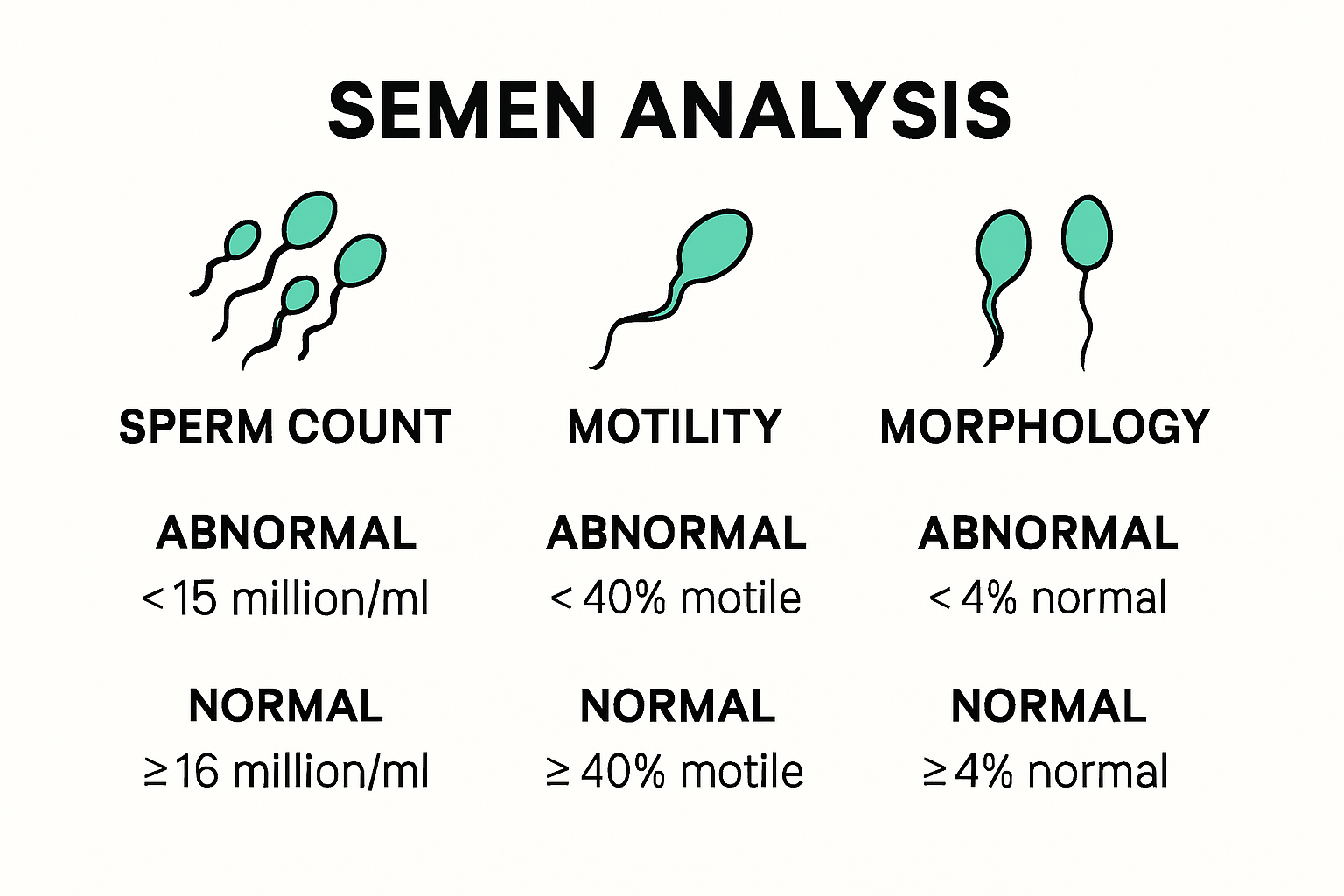
How to Handle Abnormal Results for At-Home Reproductive Health Testing 2025
| Undeez

Getting an abnormal result from an at-home reproductive health test can feel like a punch to the gut. You might expect the worst after seeing numbers outside the normal range, especially since a semen analysis can flag up to 45 percent of initial tests as abnormal even if fertility is not truly at risk. It turns out those numbers rarely tell the whole story, and your next steps might actually open doors to solutions you never knew existed.
Table of Contents
- Understanding Abnormal Results In Male Health Tests
- Key Steps After Getting An Unexpected Test Result
- What Abnormal Means For Vasectomy Confirmation
- When To Seek Help And Trusted Resources
Quick Summary
| Takeaway | Explanation |
|---|---|
| Understanding Semen Analysis | Semen analysis is critical for assessing male reproductive health, focusing on parameters like sperm count, motility, and morphology, which require careful interpretation as abnormal results may not indicate infertility. |
| Emotional Response Management | Initial emotional reactions to abnormal results are normal; incorporating coping strategies like seeking support and avoiding catastrophic thinking can facilitate better processing of the news. |
| Proactive Medical Consultation | After receiving unexpected results, it’s important to consult a healthcare provider promptly, bringing all relevant documentation and seeking comprehensive explanations and follow-up testing for clarification. |
| Developing an Action Plan | Collaborate with healthcare providers to establish a personalized action plan, addressing potential reproductive health challenges through lifestyle changes, treatments, and psychological support resources. |
| When to Seek Professional Help | Recognize specific triggers for professional consultation, such as prolonged inability to conceive or persistent abnormal results, to ensure timely and effective reproductive health management. |
Understanding Abnormal Results in Male Health Tests
Abnormal results in male reproductive health tests can trigger significant anxiety and uncertainty. Understanding these results requires a structured approach that combines medical insight, professional interpretation, and personal context.
Decoding Semen Analysis Parameters
Semen analysis represents a critical diagnostic tool for assessing male reproductive health. When analyzing test results, healthcare professionals examine multiple parameters that provide comprehensive insights into fertility potential. Learn more about advanced sperm function evaluations.
According to research from the National Institutes of Health, key parameters include:
- Sperm Count: Indicates the total number of sperm in a sample
- Motility: Measures sperm movement and swimming capability
- Morphology: Evaluates sperm shape and structural characteristics
Abnormal results in these parameters do not automatically signify infertility. Multiple factors can temporarily influence semen quality, including recent illness, stress, lifestyle choices, and environmental exposures.

Clinical Interpretation and Next Steps
When confronted with unexpected test results, understanding the nuanced clinical interpretation becomes paramount. According to American Academy of Family Physicians, distinguishing between primary and secondary hypogonadism requires comprehensive hormonal assessment.
Healthcare professionals typically recommend a staged approach to abnormal results:
- Confirm the initial test findings through repeat testing
- Conduct comprehensive hormonal panels
- Evaluate potential lifestyle and environmental influences
- Consider specialized diagnostic procedures if initial results suggest significant abnormalities
Specialists might investigate underlying conditions such as hormonal imbalances, genetic factors, or potential inflammatory processes that could impact reproductive health. The goal is not just identifying anomalies but understanding their root causes and potential interventions.
Patients should approach abnormal results with a balanced perspective. While initial findings might seem concerning, modern medical diagnostics offer sophisticated methods for comprehensive evaluation and potential treatment strategies. Open communication with healthcare providers, maintaining a calm demeanor, and being prepared for additional testing can transform an anxious experience into a proactive health management journey.
Understand post-test result strategies for vasectomy confirmation to gain additional insights into navigating complex reproductive health assessments.
To help readers quickly understand the major semen analysis parameters and what abnormal results may imply, the following table summarizes these key factors:
| Parameter | What It Measures | Possible Meaning of Abnormal Result |
|---|---|---|
| Sperm Count | Number of sperm in the semen sample | Low may indicate decreased fertility potential |
| Motility | Percentage of moving/active sperm | Low may reduce chances of successful conception |
| Morphology | Percentage of sperm with normal shape | High abnormal forms may be linked to fertility issues |
Key Steps After Getting an Unexpected Test Result
Receiving unexpected reproductive health test results can be emotionally overwhelming and challenging. Navigating this experience requires a strategic approach that balances emotional resilience with informed medical decision making.
Initial Emotional Processing and Response
The first moments after encountering abnormal test results often trigger intense emotional reactions. Explore comprehensive post-test support strategies to help manage psychological responses effectively.
According to research published in the National Center for Biotechnology Information, individuals frequently experience a range of emotions including shock, anxiety, and uncertainty when confronting unexpected medical findings. Recognizing these emotional responses as normal is crucial.
Recommended initial coping strategies include:
- Pause and Breathe: Take deliberate moments to center yourself
- Avoid Immediate Catastrophic Thinking: Refrain from assuming worst-case scenarios
- Seek Immediate Support: Contact a trusted partner, family member, or friend

Professional Consultation and Verification
Following the initial emotional response, professional medical consultation becomes paramount. The American College of Obstetricians and Gynecologists emphasizes the importance of prompt and comprehensive medical follow-up.
Essential steps in professional consultation include:
- Schedule an appointment with a healthcare provider within one week of receiving results
- Bring all original test documentation and any additional relevant medical history
- Prepare a list of specific questions and concerns to discuss during the consultation
- Request a comprehensive explanation of the test results and potential implications
Healthcare professionals will likely recommend additional diagnostic tests to confirm initial findings. These might include more comprehensive semen analyses, hormonal panels, genetic screenings, or specialized imaging studies designed to provide a more nuanced understanding of the initial results.
The table below provides a checklist summary of key actions to take after receiving unexpected test results:
| Step | Recommended Action | Completed (Y/N) |
|---|---|---|
| Schedule Medical Appointment | Within 1 week of results | |
| Gather Documentation | Bring all test records | |
| Prepare Key Questions | List concerns for doctor | |
| Request Detailed Explanation | Seek full clarification | |
| Undergo Follow-up Testing | As advised by provider |
Developing a Personalized Action Plan
Transforming unexpected test results into a proactive health management strategy requires collaborative planning with healthcare providers. The goal is not just understanding the results but developing a comprehensive approach to address potential reproductive health challenges.
Key components of an effective action plan typically involve:
- Detailed medical assessment and potential underlying condition investigations
- Lifestyle modification recommendations
- Potential treatment or intervention strategies
- Follow-up testing timelines
- Emotional and psychological support resources
Remember that abnormal test results do not definitively indicate permanent reproductive health issues. Modern medical technologies and interventions offer numerous pathways for addressing and potentially resolving reproductive health challenges. Maintaining open communication with healthcare providers, staying informed, and approaching the situation with a balanced perspective are critical to navigating this complex journey.
What Abnormal Means for Vasectomy Confirmation
Vasectomy confirmation represents a critical step in male reproductive health management. Understanding what abnormal results mean can help patients navigate potential complications and make informed decisions about their reproductive health. Learn how to interpret vasectomy test results accurately.
Understanding Post-Vasectomy Semen Analysis
According to StatPearls medical research, post-vasectomy semen analysis (PVSA) is typically performed 8 to 16 weeks after the procedure. The primary objective is to confirm complete sterilization by identifying the absence of sperm or the presence of rare non-motile sperm.
Key parameters in post-vasectomy testing include:
- Sperm Count: Should be zero or demonstrate extremely low, non-motile sperm
- Motility: No active sperm movement should be detectable
- Concentration: Ideally showing complete azoospermia
Abnormal results can indicate several potential scenarios:
- Incomplete vasectomy procedure
- Spontaneous recanalization of vas deferens
- Technical errors during initial surgical intervention
Clinical Implications of Abnormal Results
Research published in recent medical studies highlights the importance of understanding post-vasectomy testing compliance. A 2020 study examining home-based testing kits found that patient compliance rates were slightly higher with at-home testing methods, though not statistically significant.
When abnormal results are detected, healthcare providers typically recommend:
- Repeat semen analysis within 4-6 weeks
- Comprehensive medical evaluation
- Potential surgical re-examination
- Additional contraceptive precautions
Patients should not panic upon receiving abnormal results. Modern medical technologies and follow-up procedures offer multiple pathways to address potential issues. The key is maintaining open communication with healthcare providers and following recommended testing protocols.
Next Steps and Patient Guidance
Abnormal vasectomy confirmation results do not necessarily mean permanent fertility restoration. Explore comprehensive post-vasectomy confirmation strategies to understand your options.
Critical recommendations for patients include:
- Continuing alternative contraception methods
- Scheduling follow-up consultations
- Maintaining detailed medical documentation
- Avoiding assumptions about fertility status
The journey of vasectomy confirmation requires patience, professional guidance, and a systematic approach. While abnormal results might initially cause concern, they provide an opportunity for thorough medical assessment and potential intervention. Healthcare providers can offer personalized strategies to address individual circumstances and ensure reproductive health management.
When to Seek Help and Trusted Resources
Navigating reproductive health challenges requires knowing when and where to seek professional guidance. Understanding the right time to consult healthcare professionals can significantly impact treatment outcomes and personal well-being.
Recognizing Critical Consultation Triggers
Understand comprehensive reproductive health evaluation strategies to help identify when professional intervention becomes essential.
According to research from the Academy of Medicine-Ministry of Health Clinical Practice Guidelines, specific scenarios warrant immediate professional consultation:
- Inability to conceive after prolonged attempts
- Women under 30: After two years of unprotected intercourse
- Women over 30: After one year of unprotected intercourse
- Known reproductive health complications
- Persistent abnormal test results
- Significant changes in reproductive health parameters
Critical signs indicating the need for immediate medical consultation include unexplained fertility challenges, recurrent abnormal test results, and potential underlying health conditions affecting reproductive function.
Professional Evaluation and Diagnostic Pathways
The American Urological Association and American Society for Reproductive Medicine emphasize a systematic approach to reproductive health assessment. This involves comprehensive evaluations that consider multiple factors beyond initial test results.
A typical professional consultation might include:
- Detailed medical history review
- Comprehensive physical examination
- Advanced diagnostic testing
- Potential referral to specialized reproductive health experts
- Personalized treatment strategy development
Healthcare professionals recommend a holistic approach that considers physical, psychological, and lifestyle factors influencing reproductive health. The goal is not just identifying issues but developing comprehensive, personalized management strategies.
Accessing Reliable Support and Information
Identifying trustworthy resources is crucial for effective reproductive health management. Explore expert-recommended support networks to enhance your understanding and support system.
Reliable resources include:
- Board-certified reproductive health specialists
- Accredited medical research institutions
- Professional medical associations
- Verified online health platforms
- Support groups with medical supervision
The Centers for Disease Control and Prevention recommends seeking information from authoritative sources and maintaining open communication with healthcare providers. Patients should be proactive in understanding their health, asking questions, and participating actively in their healthcare journey.
Remember that seeking help is a sign of strength, not weakness. Reproductive health challenges are complex, and professional guidance can provide clarity, support, and potential solutions. Approach your health journey with patience, openness, and a commitment to comprehensive care.
Frequently Asked Questions
What should I do if I receive abnormal results from my at-home reproductive health test?
Receiving abnormal results can be alarming. First, take a moment to process your emotions. Then, schedule a consultation with a healthcare provider to discuss the results, ask questions, and explore potential next steps, including additional testing if necessary.
Are abnormal semen analysis results a sign of infertility?
Not necessarily. Abnormal semen analysis results can occur for various reasons, including temporary factors like stress or lifestyle choices. It’s important to interpret these results in context with guidance from a healthcare professional.
How can I manage my emotions after receiving unexpected test results?
It’s normal to experience a range of emotions after receiving unexpected results. Recommended coping strategies include taking deep breaths, seeking support from friends or family, and avoiding catastrophic thinking. Allow yourself time to process the information before making decisions.
When should I seek professional help for reproductive health issues?
You should seek professional help if you experience prolonged difficulty in conceiving, persistent abnormal test results, or any significant changes in your reproductive health. Specific triggers include infertility after a year of trying (or six months if over 35), and any known reproductive health complications.
Move Forward in Reproductive Health Recovery With Proven Comfort
If abnormal results from your vasectomy or fertility testing have left you feeling stressed or uncertain, you are not alone. Sensitive post-op periods can be both emotionally and physically taxing. Concerns about swelling, discomfort, and whether you are healing properly often add to the pressure of waiting for follow-up results. The anxiety of recovery and wanting to do everything right can feel overwhelming.
You deserve tools that offer confidence while your body heals. At Undeez, we have designed our Vasectomy Recovery Underwear and Recovery Jockstrap to target exactly these recovery pain points. Every pair comes with dual-compartment pouches and reusable gel ice packs, giving you relief and support just where you need it. Thousands of men recommend our products for reducing pain, swelling, and the stress that comes with post-vasectomy monitoring. Take control of your recovery journey and feel the difference for yourself. Visit our official store today to choose the recovery support that fits your needs. If you want expert-backed comfort and peace of mind while you await results, now is the time to act.
